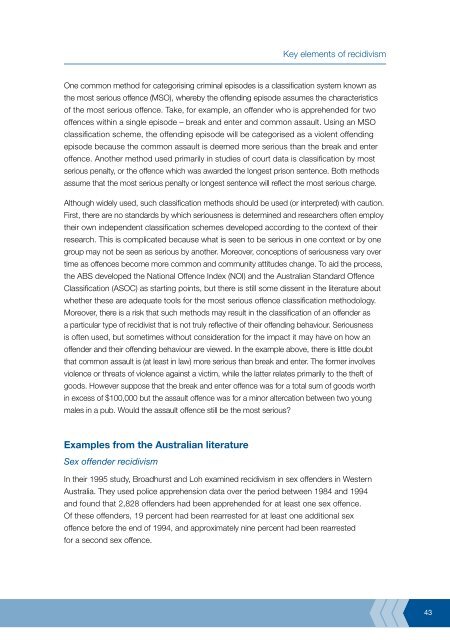Recidivism in Australia : findings and future research - Australian ...
Recidivism in Australia : findings and future research - Australian ...
Recidivism in Australia : findings and future research - Australian ...
You also want an ePaper? Increase the reach of your titles
YUMPU automatically turns print PDFs into web optimized ePapers that Google loves.
One common method for categoris<strong>in</strong>g crim<strong>in</strong>al episodes is a classification system known as<br />
the most serious offence (MSO), whereby the offend<strong>in</strong>g episode assumes the characteristics<br />
of the most serious offence. Take, for example, an offender who is apprehended for two<br />
offences with<strong>in</strong> a s<strong>in</strong>gle episode – break <strong>and</strong> enter <strong>and</strong> common assault. Us<strong>in</strong>g an MSO<br />
classification scheme, the offend<strong>in</strong>g episode will be categorised as a violent offend<strong>in</strong>g<br />
episode because the common assault is deemed more serious than the break <strong>and</strong> enter<br />
offence. Another method used primarily <strong>in</strong> studies of court data is classification by most<br />
serious penalty, or the offence which was awarded the longest prison sentence. Both methods<br />
assume that the most serious penalty or longest sentence will reflect the most serious charge.<br />
Although widely used, such classification methods should be used (or <strong>in</strong>terpreted) with caution.<br />
First, there are no st<strong>and</strong>ards by which seriousness is determ<strong>in</strong>ed <strong>and</strong> <strong>research</strong>ers often employ<br />
their own <strong>in</strong>dependent classification schemes developed accord<strong>in</strong>g to the context of their<br />
<strong>research</strong>. This is complicated because what is seen to be serious <strong>in</strong> one context or by one<br />
group may not be seen as serious by another. Moreover, conceptions of seriousness vary over<br />
time as offences become more common <strong>and</strong> community attitudes change. To aid the process,<br />
the ABS developed the National Offence Index (NOI) <strong>and</strong> the <strong>Australia</strong>n St<strong>and</strong>ard Offence<br />
Classification (ASOC) as start<strong>in</strong>g po<strong>in</strong>ts, but there is still some dissent <strong>in</strong> the literature about<br />
whether these are adequate tools for the most serious offence classification methodology.<br />
Moreover, there is a risk that such methods may result <strong>in</strong> the classification of an offender as<br />
a particular type of recidivist that is not truly reflective of their offend<strong>in</strong>g behaviour. Seriousness<br />
is often used, but sometimes without consideration for the impact it may have on how an<br />
offender <strong>and</strong> their offend<strong>in</strong>g behaviour are viewed. In the example above, there is little doubt<br />
that common assault is (at least <strong>in</strong> law) more serious than break <strong>and</strong> enter. The former <strong>in</strong>volves<br />
violence or threats of violence aga<strong>in</strong>st a victim, while the latter relates primarily to the theft of<br />
goods. However suppose that the break <strong>and</strong> enter offence was for a total sum of goods worth<br />
<strong>in</strong> excess of $100,000 but the assault offence was for a m<strong>in</strong>or altercation between two young<br />
males <strong>in</strong> a pub. Would the assault offence still be the most serious?<br />
Examples from the <strong>Australia</strong>n literature<br />
Sex offender recidivism<br />
Key elements of recidivism<br />
In their 1995 study, Broadhurst <strong>and</strong> Loh exam<strong>in</strong>ed recidivism <strong>in</strong> sex offenders <strong>in</strong> Western<br />
<strong>Australia</strong>. They used police apprehension data over the period between 1984 <strong>and</strong> 1994<br />
<strong>and</strong> found that 2,828 offenders had been apprehended for at least one sex offence.<br />
Of these offenders, 19 percent had been rearrested for at least one additional sex<br />
offence before the end of 1994, <strong>and</strong> approximately n<strong>in</strong>e percent had been rearrested<br />
for a second sex offence.<br />
43















